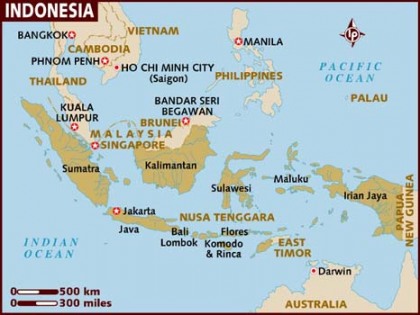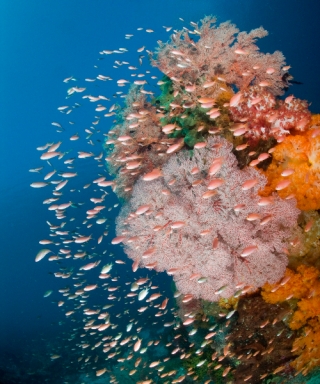Komodo Deep South
Komodo – The Land That Time Forgot
Komodo! Mention the word in company almost anywhere and you are likely to get the same reaction; hushed mutterings about a mythical, far away land dominated by barren sun scorched mountains and low lying primordial forests set on islands surrounded by dazzling coral reefs. The conversation would then follow that these islands are protected by the fierce currents of a treacherous deep blue sea and ruled over by the most awe inspiring predator on the planet!
And you know what? This description is about as close as it gets!
Recently in November 2011, Komodo National Park was voted as one of the New 7 Wonders of the World in the nature category, beating the world famous Great Barrier Reef of Australia and Tubbataha Reefs in Philippines.
Welcome to Komodo, the “Land That Time Forgot”.
Komodo – Where is it?
* Middle of the Indonesian archipelago
* 8 degrees south of the equator, 120 degrees east
* 250 nautical miles east of Bali
* Between the islands of Sumbawa and Flores
Komodo Deep South- Getting there
The Ombak Biru cruises are 8 day programmes and start on the island of Bali, easily accessible from the USA and Europe through many Asian hubs. Once in Bali our guests make the short flight to Labuhanbajo on the island of Flores. After landing there is a short trip to the harbour before boarding the vessel. This itinerary entire
cruise is focused on diving South Komodo National Park where we will cover Padar Island, Langkoi,
Horseshoe Bay, South West Flores, Mota Island and the Mola Straits (The channel between Rinca Island and Flores).
This is only possible in the 1st quarter of the year during the North West Monsoon). Mota Island and Mola Straits are only available in this itinerary only. There will be the walk on Rinca Island to see the Komodo Dragons. Highlights of the itinerary : Manta rays and occasional Molas in Langkoi, excellent macro life, schooling fishes such as, bumphead wrasses, excellent soft coral growth,torpedo rays, sea apples in Mota Island, the Dragon Walk.
The Komodo National Park
Established in 1980 as a UNESCO World Heritage Site the Komodo National Park is located some 250 nautical miles east of Bali and 8 degrees below the equator, deep in the Indonesian archipelago between the islands of Sumbawa and Flores. Encompassing 1,817 square kilometers and comprising the three main islands, Komodo, Rinca and Padar as well as many other smaller islets and rocky sea mountains, the park is considered to be one of the most exciting natural world adventure destinations on the planet. Intrepid travelers here can experience one of the richest marine environments in the world; get up close and personal with the ferocious Komodo Dragons along with many other fascinating land and sea encounters and excursions.
Marine Komodo
The huge island nation of Indonesia is home to the world’s most prolific marine ecosystem and the Komodo National Park is right at the epicenter of all with wild activity and in the middle of The Coral Triangle. It is part of the Indonesian Throughflow, an important ocean current that carries water from the Pacific to the Indian Ocean, hence the totally different contrast in Marine Environment between North & South Komodo. Most world class diving sites are usuallyformed by either unusual volcanic formations of undersea rock or extensive deposits of coral limestone, washed over by nutrient rich marine currents. Fortunately during its evolution the Komodo region of Indonesia has been blessed with all of this! This spectacular seascape is comprised mainly of volcanic seamounts, pinnacles, walls and canyons as well as fringing reefs, coral gardens, mangrove bays and sandy slopes; creating an unmatched variety of very different and distinctive dive environments.
South
The range of dive sites and conditions in Komodo are legendary and the northern and southern sides of the park offer two distinct underwater environments. The Flores Sea is to the north and the Indian Ocean lies to the south and these two vast seas are connected by the Sape, Linta and Molo Straits. Between the months of March and November the clear warm waters flowing from the Banda and Flores Seas wash over the pristine hard coral gardens and seamounts in the north while in the south, deep cold water current from the Indian Ocean collide with the continental shelf causing upwelling’s that produce a vast plankton banquet for the marine life here. Between the months of December and February these water conditions are reversed with warm blue water lighting up the south while colder, greener conditions are evident on the northern sites. During a single day water temperatures can vary wildly between 30 to 18 degrees in just a short distance at some times of the year.
Fierce currents
Komodo is justly famous for its high energy adrenaline pumping dives and the gusting currents that surge and swirl through the deep channels around the seamounts between Komodo, Padar and Rinca islands and are the key to the parks wonderful marine life. These immense water movements produce such a wild variety of conditions that there is something here for everybody. Great visibility, massive cliffs of black basalt, sheer walls and dazzling coral gardens all combine to house one of the most prolific and diverse undersea ecosystem on earth!
Topside
Komodo Topside, the landscape is dotted with islands and islets of every description, their volcanic bases have been carved by eons of ocean wear, but their crowns are distinctive and unique. While most of Indonesia is green and tropically lush, Komodo is much dryer featuring lofty rocky peaks, creature filled green forests and grassy slopes and meadows that give a savanna type feel to the landscape; the a perfect habitat for its most famous resident, the Komodo dragon, the largest lizard on earth!
Beaches
The beaches of Komodo are a dream, sandy with a background of rocks and hills and mostly deserted. Great for trekking and beachcombing but not a good place for sunbathing however, you have to remember what else lives here. Looking at the sand on some of these beaches brings yet another surprise, it appears to be pink in colour, and it actually is! The vermillion organ pipe coral that thrive in Komodo does not lose its pigment when it dies, it just washes up on these beaches and gets crushed and ground up with the regular white sand and produces this remarkable candy floss colouration.




